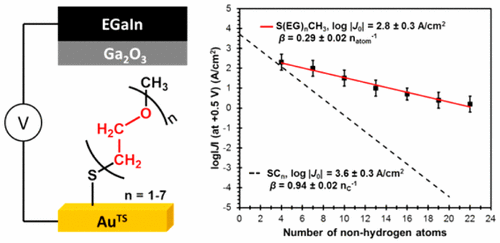当前位置:
X-MOL 学术
›
J. Am. Chem. Soc.
›
论文详情
Our official English website, www.x-mol.net, welcomes your
feedback! (Note: you will need to create a separate account there.)
Anomalously Rapid Tunneling: Charge Transport across Self-Assembled Monolayers of Oligo(ethylene glycol)
Journal of the American Chemical Society ( IF 14.4 ) Pub Date : 2017-05-11 00:00:00 , DOI: 10.1021/jacs.7b02770 Mostafa Baghbanzadeh 1 , Carleen M. Bowers 1 , Dmitrij Rappoport 1 , Tomasz Żaba 2 , Li Yuan 1 , Kyungtae Kang 1 , Kung-Ching Liao 1 , Mathieu Gonidec 1, 3 , Philipp Rothemund 1 , Piotr Cyganik 2 , Alan Aspuru-Guzik 1 , George M. Whitesides 1, 4, 5
Journal of the American Chemical Society ( IF 14.4 ) Pub Date : 2017-05-11 00:00:00 , DOI: 10.1021/jacs.7b02770 Mostafa Baghbanzadeh 1 , Carleen M. Bowers 1 , Dmitrij Rappoport 1 , Tomasz Żaba 2 , Li Yuan 1 , Kyungtae Kang 1 , Kung-Ching Liao 1 , Mathieu Gonidec 1, 3 , Philipp Rothemund 1 , Piotr Cyganik 2 , Alan Aspuru-Guzik 1 , George M. Whitesides 1, 4, 5
Affiliation

|
This paper describes charge transport by tunneling across self-assembled monolayers (SAMs) of thiol-terminated derivatives of oligo(ethylene glycol) (HS(CH2CH2O)nCH3; HS(EG)nCH3); these SAMs are positioned between gold bottom electrodes and Ga2O3/EGaIn top electrodes. Comparison of the attenuation factor (β of the simplified Simmons equation) across these SAMs with the corresponding value obtained with length-matched SAMs of oligophenyls (HS(Ph)nH) and n-alkanethiols (HS(CH2)nH) demonstrates that SAMs of oligo(ethylene glycol) have values of β (β(EG)n = 0.29 ± 0.02 natom–1 and β = 0.24 ± 0.01 Å–1) indistinguishable from values for SAMs of oligophenyls (β(Ph)n = 0.28 ± 0.03 Å–1), and significantly lower than those of SAMs of n-alkanethiolates (β(CH2)n = 0.94 ± 0.02 natom–1 and 0.77 ± 0.03 Å–1). There are two possible origins for this low value of β. The more probable involves hole tunneling by superexchange, which rationalizes the weak dependence of the rate of charge transport on the length of the molecules of HS(EG)nCH3 using interactions among the high-energy, occupied orbitals associated with the lone-pair electrons on oxygen. Based on this mechanism, SAMs of oligo(ethylene glycol)s are good conductors (by hole tunneling) but good insulators (by electron and/or hole drift conduction). This observation suggests SAMs derived from these or electronically similar molecules are a new class of electronic materials. A second but less probable mechanism for this unexpectedly low value of β for SAMs of S(EG)nCH3 rests on the possibility of disorder in the SAM and a systematic discrepancy between different estimates of the thickness of these SAMs.
中文翻译:

异常快速隧穿:跨寡聚乙二醇自组装单层的电荷传输。
本文介绍了通过隧穿跨寡聚乙二醇(HS(CH 2 CH 2 O)n CH 3; HS(EG)n CH 3)的巯基封端的衍生物的自组装单层(SAMs)进行电荷传输的方法。这些SAM位于金底电极和Ga 2 O 3 / EGaIn顶电极之间。比较这些SAM的衰减因子(简化的Simmons方程的β)与通过长度匹配的寡苯基(HS(Ph)n H)和n-链烷硫醇(HS(CH 2)nH)表明,低聚乙二醇的SAMs的β(β (EG)n = 0.29±0.02 n原子–1和β= 0.24±0.01Å –1)的值与低聚苯胺(β (Ph(Ph) )n = 0.28± 0.03Å –1),并且显着低于正构烷硫醇盐的SAMs (β (CH 2)n = 0.94±0.02 n原子–1和0.77±0.03Å –1)。β的这个低值有两个可能的来源。更有可能涉及通过超交换进行的空穴隧穿,这是通过与孤对相关的高能占据轨道之间的相互作用来合理化电荷传输速率对HS(EG)n CH 3分子长度的弱依赖性的氧上的电子。基于这种机理,低聚(乙二醇)的SAM是良好的导体(通过空穴隧穿),但是是良好的绝缘体(通过电子和/或空穴漂移传导)。该观察结果表明,衍生自这些或电子相似分子的SAM是一类新型的电子材料。S(EG)n CH 3的SAM的β值如此低的第二个但不太可能的机理 取决于SAM中无序的可能性以及这些SAM厚度的不同估计之间的系统差异。
更新日期:2017-05-25
中文翻译:

异常快速隧穿:跨寡聚乙二醇自组装单层的电荷传输。
本文介绍了通过隧穿跨寡聚乙二醇(HS(CH 2 CH 2 O)n CH 3; HS(EG)n CH 3)的巯基封端的衍生物的自组装单层(SAMs)进行电荷传输的方法。这些SAM位于金底电极和Ga 2 O 3 / EGaIn顶电极之间。比较这些SAM的衰减因子(简化的Simmons方程的β)与通过长度匹配的寡苯基(HS(Ph)n H)和n-链烷硫醇(HS(CH 2)nH)表明,低聚乙二醇的SAMs的β(β (EG)n = 0.29±0.02 n原子–1和β= 0.24±0.01Å –1)的值与低聚苯胺(β (Ph(Ph) )n = 0.28± 0.03Å –1),并且显着低于正构烷硫醇盐的SAMs (β (CH 2)n = 0.94±0.02 n原子–1和0.77±0.03Å –1)。β的这个低值有两个可能的来源。更有可能涉及通过超交换进行的空穴隧穿,这是通过与孤对相关的高能占据轨道之间的相互作用来合理化电荷传输速率对HS(EG)n CH 3分子长度的弱依赖性的氧上的电子。基于这种机理,低聚(乙二醇)的SAM是良好的导体(通过空穴隧穿),但是是良好的绝缘体(通过电子和/或空穴漂移传导)。该观察结果表明,衍生自这些或电子相似分子的SAM是一类新型的电子材料。S(EG)n CH 3的SAM的β值如此低的第二个但不太可能的机理 取决于SAM中无序的可能性以及这些SAM厚度的不同估计之间的系统差异。











































 京公网安备 11010802027423号
京公网安备 11010802027423号